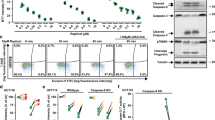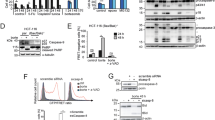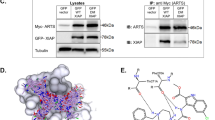Abstract
Caspase-8 is a key effector of death-receptor-triggered apoptosis. In a previous study, we demonstrated, however, that caspase-8 can also be activated in a death receptor-independent manner via the mitochondrial apoptosis pathway, downstream of caspase-3. Here, we show that caspases-3 and -8 mediate a mitochondrial amplification loop that is required for the optimal release of cytochrome c, mitochondrial permeability shift transition, and cell death during apoptosis induced by treatment with the microtubule-damaging agent paclitaxel (Taxol). In contrast, Smac release from mitochondria followed a different pattern, and therefore seems to be regulated independently from cytochrome c release. Taxol-induced cell death was inhibited by the use of synthetic, cell-permeable caspase-3- (zDEVD-fmk) or caspase-8-specific (zIETD-fmk) inhibitors. Apoptosis signaling was not affected by a dominant-negative FADD mutant (FADD-DN), thereby excluding a role of death receptor signaling in the amplification loop and drug-induced apoptosis. The inhibitor experiments were corroborated by the use of BJAB cells overexpressing the natural serpin protease inhibitor, cytokine response modifier A. These data demonstrate that the complete activation of mitochondria, release of cytochrome c, and execution of drug-induced apoptosis require a mitochondrial amplification loop that depends on caspases-3 and -8 activation. In addition, this is the first report to demonstrate death receptor-independent caspase-8 autoprocessing in vivo.
This is a preview of subscription content, access via your institution
Access options
Subscribe to this journal
Receive 50 print issues and online access
$259.00 per year
only $5.18 per issue
Buy this article
- Purchase on Springer Link
- Instant access to full article PDF
Prices may be subject to local taxes which are calculated during checkout











Similar content being viewed by others
References
Belka C, Rudner J, Wesselborg S, Stepczynska A, Marini P, Lepple-Wienhues A, Faltin H, Bamberg M, Budach W and Schulze-Osthoff K . (2000). Oncogene, 19, 1181–1190.
Belka C, Schmid B, Marini P, Durand E, Rudner J, Faltin H, Bamberg M, Schulze-Osthoff K and Budach W . (2001). Oncogene, 20, 2190–2196.
Biswas RS, Cha HJ, Hardwick JM and Srivastava RK . (2001). Mol. Cell. Biochem., 225, 7–20.
Brichese L, Barboule N, Heliez C and Valette A . (2002). Exp. Cell Res., 278, 101–111.
Calastretti A, Bevilacqua A, Ceriani C, Vigano S, Zancai P, Capaccioli S and Nicolin A . (2001). Oncogene, 20, 6172–6180.
Charles AG, Han TY, Liu YY, Hansen N, Giuliano AE and Cabot MC . (2001). Cancer Chemother. Pharmacol, 47, 444–450.
Cohen GM . (1997). Biochem. J., 326, 1–16.
Daniel PT . (2000). Leukemia, 14, 2035–2044.
Daniel PT, Sturm I, Wieder T and Schulze-Osthoff K . (2001). Leukemia, 15, 1022–1032.
Das GC, Holiday D, Gallardo R and Haas C . (2001). Cancer Lett., 165, 147–153.
Dhein J, Daniel PT, Trauth BC, Oehm A, Moller P and Krammer PH . (1992). J. Immunol, 149, 3166–3173.
Engels IH, Stepczynska A, Stroh C, Lauber K, Berg C, Schwenzer R, Wajant H, Janicke RU, Porter AG, Belka C, Gregor M, Schulze-Osthoff K and Wesselborg S . (2000). Oncogene, 19, 4563–4573.
Essmann F, Wieder T, Otto A, Muller EC, Dorken B and Daniel PT . (2000). Biochem. J., 346, 777–783.
Fadeel B, Orrenius S and Zhivotovsky B . (2000). Leukemia, 14, 1514–1525.
Friedrich K, Wieder T, von Haefen C, Radetzki S, Jänicke R, Schulze-Osthoff K, Dörken B and Daniel PT . (2001). Oncogene, 20, 2749–2760.
Friesen C, Fulda S and Debatin KM . (1999). Leukemia, 13, 1854–1858.
Fulda S, Kufer MU, Meyer E, van Valen F, Dockhorn-Dworniczak B and Debatin KM . (2001a). Oncogene, 20, 5865–5877.
Fulda S, Meyer E, Friesen C, Susin SA, Kroemer G and Debatin KM . (2001b). Oncogene, 20, 1063–1075.
Garcia-Calvo M, Peterson EP, Leiting B, Ruel R, Nicholson DW and Thornberry NA . (1998). J. Biol. Chem., 273, 32608–32613.
Hemmati PG, Gillissen B, von Haefen C, Wendt J, Stärck L, Güner D, Dörken B and Daniel PT . (2002). Oncogene, 21, 3149–3161.
Huang Y, Sheikh MS, Fornace Jr AJ and Holbrook NJ . (1999). Oncogene, 18, 3431–3439.
Kischkel FC, Lawrence DA, Tinel A, LeBlanc H, Virmani A, Schow P, Gazdar A, Blenis J, Arnott D and Ashkenazi A . (2001). J. Biol. Chem., 276, 46639–46646.
Kitamura K, Minami Y, Yamamoto K, Akao Y, Kiyoi H, Saito H and Naoe T . (2000). Leukemia, 14, 1743–1750.
Korsmeyer SJ, Wei MC, Saito M, Weiler S, Oh KJ and Schlesinger PH . (2000). Cell Death Differ., 7, 1166–1173.
Lambert IH, Hoffmann EK and Jorgensen F . (1989). J Membr Biol., 111, 113–131.
Los M, Wesselborg S and Schulze-Osthoff K . (1999). Immunity, 10, 629–639.
Madesh M, Antonsson B, Srinivasula SM, Alnemri ES and Hajnoczky G . (2002). J. Biol. Chem., 277, 5651–5659.
Muzio M, Chinnaiyan AM, Kischkel FC, O'Rourke K, Shevchenko A, Ni J, Scaffidi C, Bretz JD, Zhang M, Gentz R, Mann M, Krammer PH, Peter ME and Dixit VM . (1996). Cell, 85, 817–827.
Muzio M, Stockwell BR, Stennicke HR, Salvesen GS and Dixit VM . (1998). J Biol Chem., 273, 2926–2930.
Newton K and Strasser A . (2000). J. Exp. Med., 191, 195–200.
Nicholson DW . (1999). Cell Death Differ., 6, 1028–1042.
Nomura Y, Inanami O, Takahashi K, Matsuda A and Kuwabara M . (2000). Leukemia, 14, 299–306.
Oyaizu H, Adachi Y, Taketani S, Tokunaga R, Fukuhara S and Ikehara S . (1999). Mol. Cell. Biol. Res. Commun., 2, 36–41.
Pan J, Xu G and Yeung SC . (2001). J. Clin. Endocrinol. Metab., 86, 4731–4740.
Perkins CL, Fang G, Kim CN and Bhalla KN . (2000). Cancer Res., 60, 1645–1653.
Prokop A, Wieder T, Sturm I, Essmann F, Seeger K, Wuchter C, Ludwig W-D, Henze G, Dörken B and Daniel PT . (2000). Leukemia, 14, 1606–1613.
Radetzki S, Köhne CH, von Haefen C, Gillissen B, Sturm I, Dörken B and Daniel PT . (2002). Oncogene, 21, 227–238.
Reers M, Smiley ST, Mottola-Hartshorn C, Chen A, Lin M and Chen LB . (1995). Methods Enzymol., 260, 406–417.
Rokhlin OW, Guseva N, Tagiyev A, Knudson CM and Cohen MB . (2001). Oncogene, 20, 2836–2843.
Slee EA, Keogh SA and Martin SJ . (2000). Cell Death Differ., 7, 556–565.
Smith PK, Krohn RI, Hermanson GT, Mallia AK, Gartner FH, Provenzano MD, Fuijmoto EK, Geoke NM, Olson BJ and Klenk DC . (1985). Anal Bicohem., 150, 76–85.
Stepczynska A, Lauber K, Engels IH, Janssen O, Kabelitz D, Wesselborg S and Schulze-Osthoff K . (2001). Oncogene, 20, 1193–1202.
Sugiyama T, Shimizu S, Matsuoka Y, Yoneda Y and Tsujimoto Y . (2002). Oncogene, 21, 4944–4956.
Suliman A, Lam A, Datta R and Srivastava RK . (2001). Oncogene, 20, 2122–2133.
Suzuki A, Kawabata T and Kato M . (1998). Eur. J. Pharmacol., 343, 87–92.
Thornberry NA and Lazebnik Y . (1998). Science, 281, 1312–1316.
von Haefen C, Wieder T, Gillissen B, Stärck L, Graupner V, Dörken B and Daniel PT . (2002). Oncogene, 21, 4009–4019.
Wang LG, Liu XM, Kreis W and Budman DR . (1999). Cancer Chemother. Pharmacol., 44, 355–361.
Wesselborg S, Engels IH, Rossmann E, Los M and Schulze-Osthoff K . (1999). Blood, 93, 3053–3063.
Wieder T, Essmann F, Prokop A, Schmelz K, Schulze-Osthoff K, Beyaert R, Dörken B and Daniel PT . (2001). Blood, 97, 1378–1387.
Zamzami N, El Hamel C, Maisse C, Brenner C, Munoz-Pinedo C, Belzacq AS, Costantini P, Vieira H, Loeffler M, Molle G and Kroemer G . (2000). Oncogene, 19, 6342–6350.
Zhou Q, Snipas S, Orth K, Muzio M, Dixit VM and Salvesen GS . (1997). J. Biol. Chem., 272, 7797–7800.
Acknowledgements
The technical assistance of Antje Richter is gratefully acknowledged. We thank AM Chinnaiyan and VM Dixit (Ann Arbor, MI, USA) for providing the dominant-negative FADD (FADD-DN) construct. BJAB Bcl-xL and vector controls were kindly provided by S Fulda, University of Ulm, Germany. This work was supported by grants from the Deutsche Forschungsgemeinschaft (SFB 506 and Da238/4-1), the European Union TMR program, and the Deutsche José Carreras Leukämie-Stiftung e. V. (DJCLS-R01/02).
Author information
Authors and Affiliations
Corresponding author
Rights and permissions
About this article
Cite this article
von Haefen, C., Wieder, T., Essmann, F. et al. Paclitaxel-induced apoptosis in BJAB cells proceeds via a death receptor-independent, caspases-3/-8-driven mitochondrial amplification loop. Oncogene 22, 2236–2247 (2003). https://doi.org/10.1038/sj.onc.1206280
Received:
Revised:
Accepted:
Published:
Issue Date:
DOI: https://doi.org/10.1038/sj.onc.1206280
Keywords
This article is cited by
-
In-vivo studies of targeted and localized cancer drug release from microporous poly-di-methyl-siloxane (PDMS) devices for the treatment of triple negative breast cancer
Scientific Reports (2024)
-
Fungal 7-epi-10-deacetyltaxol produced by an endophytic Pestalotiopsis microspora induces apoptosis in human hepatocellular carcinoma cell line (HepG2)
BMC Complementary and Alternative Medicine (2017)
-
The role of individual caspases in cell death induction by taxanes in breast cancer cells
Cancer Cell International (2015)
-
Apoptosis resistance, mitotic catastrophe, and loss of ploidy control in Burkitt lymphoma
Journal of Molecular Medicine (2015)
-
Caspase-cleaved arrestin-2 and BID cooperatively facilitate cytochrome C release and cell death
Cell Death & Differentiation (2014)



